|
|
Fermilab's cutting-edge accelerator R&D area renamed FAST Facility
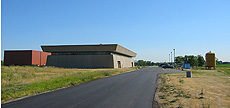 |
The former New Muon Lab is now incorporated as part of the Fermilab Accelerator Science and Technology (FAST) Facility. The Cryomodule Test Facility is visible to the left. Photo: Jerry Leibfritz, AD |
As America's premier particle accelerator laboratory, Fermilab has been making strides in its accelerator R&D program, including the construction of a cutting-edge accelerator research test bed.
This accelerator R&D lab, Fermilab's most advanced and modern, has just gotten a new and fitting name: the FAST Facility.
The Fermilab Accelerator Science and Technology Facility provides beams and test infrastructure critical to the research and development of future accelerators for the U.S. high-energy physics community, as well as for Fermilab's university and commercial partners.
FAST consists of an electron injector, a proton injector, and an electron and proton storage ring, called IOTA (Integrable Optics Test Accelerator). FAST also includes all the associated infrastructure currently housed at the New Muon Lab, which is located near the north side of the Fermilab site.
Scientists, engineers and technicians will use the renamed FAST Facility to explore options for the Fermilab accelerator complex upgrade beyond currently pursued PIP-II linac. This includes novel synchrotron concepts for delivering record-intensity particle beams with a high degree of control and the advancement of superconducting radio-frequency accelerator technology.
Stay tuned for milestones from FAST.
|
In memoriam: Bob Kingsley
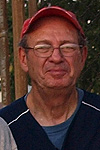 |
|
Bob Kingsley
|
Longtime Fermilab employee Robert (Bob) C. Kingsley, 70, of Oswego, Illinois, and Fort Myers, Florida, passed away Sunday, June 7, in Fort Myers. Bob was born on Jan. 29, 1945, in Aurora, Illinois, and came to work in Fermilab's ES&H Section (now ESH&Q Section) from August 1979 until October 2004, completing 25 years of service.
A lifelong resident of the local area, Bob loved to fish and play softball with his Fermilab friends. He enjoyed volunteering with Helping Hands at the Dreyer Medical Clinics and delivering pet food for the Fox Valley Animal Welfare League to senior citizens for their pets. He loved singing and shared this special talent by singing in the Jubilate Choir at St. Thomas the Apostle Catholic Church in Naperville, Illinois, and in the Resurrection Choir at St. Anne Catholic Church in Oswego. Bob was very well known at Fermilab for his upbeat personality and his can-do work ethic.
A mass of Christian burial will be celebrated on Tuesday, June 23, at 10 a.m. at St. Anne Catholic Church, 551 Boulder Hill Pass, Oswego. Visitation will take place Monday, June 22, from 5-7 p.m. at Churchill Club, 273 Bluegrass Parkway, Oswego.
The family requests that in lieu of flowers you consider donations to his favorite charity: Fox Valley Animal Welfare League, 11 John St., North Aurora, Illinois 60542.
—Don Cossairt, ESH&Q
|
Japan's next big neutrino project
 |
The proposed Hyper-K experiment would dwarf its predecessor. Photo: Sandbox Studio |
In 1998, the Super-K detector in Japan revealed that ubiquitous, almost massless particles called neutrinos have the ability to morph from one type to another. That landmark finding has become one of the most heavily cited scientific results in particle physics.
Now scientists have proposed to build a successor to the still-operating Super-K: Hyper-K, a detector with an active volume 25 times its size.
Part microscope and part telescope, the proposed Hyper-K experiment could fill in some of the blanks in our understanding of our universe. It could help explain why the universe favors matter over antimatter. It could provide new details about the fluctuating "flavors" or types of neutrinos. It could help elucidate whether there is any difference between neutrinos and their antiparticles.
It could also provide a better understanding of dark matter and exploding stars and could reveal whether protons — a main ingredient in all atoms — have an expiration date.
The proposed experiment would be complementary to DUNE, a planned long-baseline neutrino experiment in the United States that will use different technology.
Read more
—Glenn Roberts Jr.
|
|
The strong/weak force
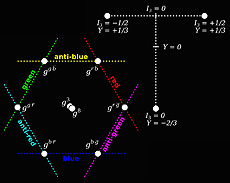 |
| Click to enlarge. The symmetries of the strong force (left) and the weak force (right) might be unified in a suite of particles that transform as a color-octet weak-triplet. (Strong force charges are called colors, merely because they are built from three fundamental values, like the primary colors). |
When describing a result from the CMS experiment, I usually try to relate it to everyday experience because it reminds me that the esoteric phenomena observed at the LHC are as much a part of our world as the arc of a falling ball. These connections are more than metaphors since physics at all scales follows the same general principles, such as energy conservation, angular momentum and wave dynamics. However, the result I'll be describing here is unlike anything we see in everyday life.
Of the four fundamental forces, the strong force and the weak force are the only two that have no visible effect on the macroscopic world (which is also why they never got good names). The strong force holds quarks together with gluons, and the weak force slowly transmutes particles via W and Z bosons. As far as we know, these forces are unrelated, but there might be hidden relationships between them, waiting to be discovered.
For instance, there could be one fundamental kind of force that appears as two distinct interactions in low-energy experiments, where "low energy" means everything from daily life up to the LHC. To predict how a strong/weak force might behave, physicists generalize from the symmetries of the strong and weak forces separately and propose a new symmetry that combines them, the way that a drawing with both left-right symmetry and top-bottom symmetry must have four corners with the same shape.
For the strong/weak force, this means there would be new particles called color-octet weak-triplets (Θ−, Θ0, Θ+ with eight color combinations). The neutral Θ0 would decay into a gluon (which only has strong force charge) and a Z boson (which only has weak force charge) or pairs of quarks such as b quarks (which already have both kinds of charge, but not as an octet). These Θ0 particles would be produced in pairs, resulting in final states with all four decay products: a gluon jet, a Z boson and two b quarks. No combinations like this were observed in the CMS data beyond the level expected from familiar processes, so this analysis rules out the possibility that Θ0 particles exist with a mass less than half a TeV.
However, heavier Θ0 particles might still exist, and the higher-energy LHC Run 2 might reveal them. Not only would this connect the strong and weak forces, but it could also explain how the Higgs mass can be as low as it is, because the Higgs could be a composite of particles bound by this strong/weak force.
—Jim Pivarski
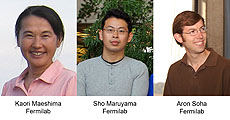 |
| These U.S. scientists conducted this analysis. |
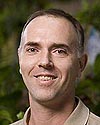 |
| Fermilab physicist Bogdan Dobrescu provided important theoretical support in the interpretation of today's analysis. |
|
Coyote in the midst
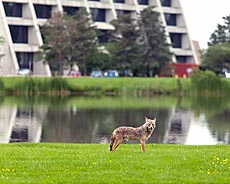 |
| A coyote hunts by Swan Lake ... Photo: Marty Murphy, AD |
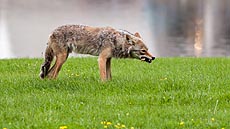 |
| ... and finds dinner. Photo: Marty Murphy, AD |
|
Einstein kills Schrödinger's cat: Relativity ruins quantum world
From New Scientist, June 16, 2015
It's been holding us back as well as holding us down. A previously overlooked effect of gravity on quantum systems could be messing up quantum experiments. If confirmed, it suggests that some quantum studies may be impossible to perform on Earth.
No matter how hard you try, you can't be in two places at once. But if you're an electron, popping up in multiple places is a way of life. The laws of quantum mechanics tell us that subatomic particles exist in this superposition of states until they are measured and found to be in just one — when their wave function collapses.
Read more
|
|